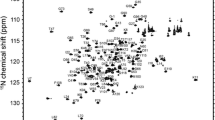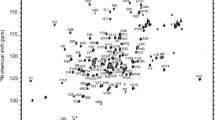Abstract
Single-stranded DNA (ssDNA)-binding proteins (SSBs) are essential for DNA replication, recombination, and repair processes in all organisms. Sulfolobus solfataricus (S. solfataricus), a hyperthermophilic species, overexpresses its SSB (S. solfataricus SSB (SsoSSB)) to protect ssDNA during DNA metabolisms. Even though the crystal structure of apo SsoSSB and its ssDNA-bound solution structure have been reported at room temperature, structural information at high temperature is not yet available. To find out how SsoSSB maintains its structure and ssDNA binding affinity at high temperatures, we performed multidimensional NMR experiments for SsoSSB at 323K. In this study, we present the backbone and side chain chemical shifts and predict the secondary structure of SsoSSB from the chemical shifts. We found that SsoSSB is ordered, even at high temperatures, and has the same fold at high temperature as at room temperature. Our data will help improve structural analyses and our understanding of the features of thermophilic proteins.


Similar content being viewed by others
References
Arunkumar AI et al (2003) Independent and coordinated functions of replication protein A tandem high affinity single-stranded DNA binding domains. J Biol Chem 278(42):41077–41082
Ashton NW et al (2013) Human single-stranded DNA binding proteins are essential for maintaining genomic stability. BMC Mol Biol 14:1–20
Brasen C, Esser D, Rauch B, Siebers B (2014) Carbohydrate metabolism in archaea: current insights into unusual enzymes and pathways and their regulation. Microbiol Mol Biol Rev 78(1):89–175. https://doi.org/10.1128/MMBR.00041-13
Brock TD, Katherine M, Brock RT, Belly, Weiss RL (1972) Sulfolobus: a new genus of sulfur-oxidizing bacteria living at low pH and high temperature. Arch Mikrobiol 84(1):54–68
Delaglio F et al (1995) NMRPipe: a multidimensional spectral processing system based on UNIX pipes. J Biomol NMR 6(3):277–293
Dickey TH, Sarah E, Altschuler, Wuttke DS (2013) Single-stranded DNA-binding proteins: multiple domains for multiple functions. Structure 21(7):1074–1084. https://doi.org/10.1016/j.str.2013.05.013
Gamsjaeger R et al (2014) Backbone and side-chain 1H, 13C and 15N resonance assignments of the OB domain of the single stranded DNA binding protein from sulfolobus solfataricus and chemical shift mapping of the DNA-binding interface. Biomol NMR Assign 8(2):243–246
Gamsjaeger R et al (2015) The structural basis of DNA binding by the single-stranded DNA-binding protein from sulfolobus solfataricus. Biochem J 465(2):337–346
Grogan D, Palm P (1990) Isolate B12, which harbours a virus-like element, represents a new species of the archaebacterial genus sulfolobus, sulfolobus shibatae, Sp. Nov. Arch Microbiol 154(6):594–599. https://doi.org/10.1007/BF00248842
Kerr ID et al (2003) Insights into SsDNA recognition by the OB fold from a structural and thermodynamic study of sulfolobus SSB protein. EMBO J 22(11):2561–2570
Lee W et al (2009) PINE-SPARKY: graphical interface for evaluating automated probabilistic peak assignments in protein NMR spectroscopy. Bioinformatics 25(16):2085–2087
Lee W et al (2016) Integrative NMR for biomolecular research. J Biomol NMR 64(4):307–332
Lee W, Markley JL (2018) PINE-SPARKY.2 for automated NMR-based protein structure research. Bioinformatics 34(9):1586–1588
Lee W et al (2019) I-PINE web server: an integrative probabilistic NMR assignment system for proteins. J Biomol NMR 73(5):213–222. https://doi.org/10.1007/s10858-019-00255-3
Lee W, Tonelli M, Markley JL (2015) NMRFAM-SPARKY: enhanced software for biomolecular NMR spectroscopy. Bioinformatics 31(8):1325–1327
Lindahl T (1972) Rate of depurination of native deoxyribonucleic acid. Biochemistry 11(19):3610–3618. https://doi.org/10.1021/bi00769a018
Morten MJ et al (2017) High-affinity RNA binding by a hyperthermophilic single-stranded DNA-binding protein. Extremophiles 21(2):369–379
Murzin AG (1993) OB(oligonucleotide/oligosaccharide binding)-fold: common structural and functional solution for non-homologous sequences. EMBO J 12(3):861–867
Mushegian AR, Koonin EV (2002) A minimal gene set for cellular life derived by comparison of complete bacterial genomes. Proc Natl Acad Sci 93(19):10268–10273
Qian Y, Johnson KA (2017) The human mitochondrial single-stranded DNA-binding protein displays distinct kinetics and thermodynamics of DNA binding and exchange. J Biol Chem 292(31):13068–13084
Quehenberger J et al (2017) Sulfolobus-a potential key organism in future biotechnology. Front Microbiol 8(DEC):1–13
Raghunathan S et al (2000) Structure of the DNA binding domain of E . Coli SSB bound to ssDNA. Nat Struct Biol 7(8):648–652
Sakai HD, and Norio Kurosawa (2018) Saccharolobus Caldissimus Gen. Nov., Sp. Nov., a Facultatively anaerobic iron-reducing hyperthermophilic archaeon isolated from an acidic terrestrial hot spring, and reclassification of sulfolobus solfataricus as saccharolobus solfataricus Comb. Nov. And. Int J Syst Evol Microbiol 68(4): 1271–1278. https://doi.org/10.1099/ijsem.0.002665
She Q et al (2001) The complete genome of the crenarchaeon sulfolobus solfataricus P2. Proc Natl Acad Sci 98(14):7835–7840. https://doi.org/10.1073/pnas.141222098
Shen Y (2013) Protein backbone and sidechain torsion angles predicted from NMR chemical shifts using artificial neural networks. J Biomol NMR 56(3):227–241
Theobald DL, Rachel M, Mitton-Fry, Deborah SWuttke (2003) Nucleic acid recognition by OB-fold proteins. Annu Rev Biophys Biomol Struct 32(1):115–133. https://doi.org/10.1146/annurev.biophys.32.110601.142506
Wang L, Eghbalnia HR, Bahrami A, Markley JL (2005) Linear analysis of carbon-13 chemical shift differences and its application to the detection and correction of errors in referencing and spin system identifications. J Biomol NMR 32(1):13–22
Zillig W et al (1980) The sulfolobus-“Caldariella” group: taxonomy on the basis of the structure of DNA-dependent RNA polymerases. Arch Microbiol 125(3):259–269
Acknowledgements
We thank GIST Central Research Facilities (GIST, Gwangju) for allowing us to use their NMR spectrometer. This work was supported by the National Research Foundation (NRF) of Korea [Grant No. 2018R1A2B6004388 to C.-J.P], which is funded by the Korean government (MSIT); by a GIST Research Institute grant funded by GIST in 2020; the National Science Foundation (NSF) [DBI-2051595 to W.L.] and the University of Colorado Denver [the start-up support to W.L.].
Author information
Authors and Affiliations
Contributions
CP and WL designed the research. MY performed the experiments. MY and WL analyzed the data. MY, WL, and CP wrote the paper.
Corresponding authors
Ethics declarations
Conflict of interest
The authors declare that they have no conflicts of interest with the contents of this article.
Additional information
Publisher’s note
Springer Nature remains neutral with regard to jurisdictional claims in published maps and institutional affiliations.
Rights and permissions
About this article
Cite this article
Yang, M.J., Lee, W. & Park, CJ. Resonance assignments and secondary structure of thermophile single‐stranded DNA binding protein from Sulfolobus solfataricus at 323K. Biomol NMR Assign 15, 159–164 (2021). https://doi.org/10.1007/s12104-020-09999-8
Received:
Accepted:
Published:
Issue Date:
DOI: https://doi.org/10.1007/s12104-020-09999-8




